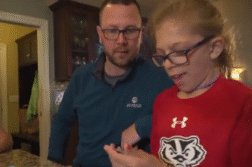ORLANDO, Fla. (Ivanhoe Newswire) – More than 20,000 babies are born needing open heart surgery. These complex procedures are a lifeline for children with congenital heart defects. Many of these surgeries can take up to 12 hours. Now, one surgeon has developed something that could transform the field of heart surgeries not only for babies, but adults, too. Blood Monitor
Every second counts in the operating room, but critical time is lost every day during open heart surgeries as doctors wait on blood test results.
Pediatric cardiac surgeon at Arnold Palmer Hospital for Children at Orlando Health, William DeCampli says, “We need a way of monitoring the status of the blood.”
Blood is taken throughout an open heart surgery so it can be tested for coagulation. Getting results from the lab can take 20 to 30 minutes.
“We would be drawing four, five, six rounds of those tests, but each one is delayed in us getting back the answer,” Dr. DeCampli explains.
This issue is particularly critical for the youngest patients who are more susceptible to complications.
“The risk to the child is a fatality,” Dr. DeCampli emphasizes.
But now, surgeons have a new tool – a real-time blood monitor. The monitor can provide instant blood analysis by using a tiny optical fiber inserted directly into the heart-lung machine.
Dr. DeCampli adds, “The light is transmitted along a very tiny optical fiber. That same optical fiber receives the signal that comes from the red blood cells as the light literally reflects off it.”
Results from the first clinical trial showed the real-time monitor was just as accurate as sending the samples to the lab. If more studies prove its effectiveness, the real-time blood monitor could be a gamechanger and life-saver in the operating room.
Researchers also believe the real-time blood monitor could be used not only for heart surgeries, but for trauma patients and even COVID patients. The team’s next clinical trial will focus on pediatric patients, with plans to expand to adult trials. If all goes well, they hope to make the blood monitor available to all hospitals within the next few years.
Contributors to this news report include: Marsha Lewis, Producer; Roque Correa, Videographer & Editor.
To receive a free weekly e-mail on medical breakthroughs from Ivanhoe, sign up at: http://www.ivanhoe.com/ftk
MEDICAL BREAKTHROUGHS
RESEARCH SUMMARY
TOPIC: REAL-TIME BLOOD MONITOR: SAVING TIME AND LIVES IN THE O.R.
REPORT: MB #5250
BACKGROUND: Babies needing open-heart surgery are born with congenital heart defects or acquired heart conditions that require surgical intervention to correct or manage the issues. There are many different kinds of open-heart surgery for babies. One in 100, or 1.3 million babies, are born with congenital heart defects each year. Over 70 percent of these babies need surgery within their first year of life.
https://medlineplus.gov/ency/article/002948.htm
https://www.mountsinai.org/health-library/surgery/pediatric-heart-surgery
DIAGNOSING: Diagnosing a need for open-heart surgery in a baby involves a diverse evaluation process that includes a medical history review, physical examinations, and various diagnostic tests. The objective is to determine the nature and severity of the heart condition, find out its impact on the baby’s health, and determine whether surgical intervention is necessary. Testing to diagnose congenital heart defects can include: pulse oximetrys, ECGs or EKGs, echocardiograms, chest x-rays, cardiac catheterizations, and heart magnetic response images.
https://www.cms.gov/Regulations-and-Guidance/Guidance/Manuals/Downloads/som107ap_v_emerg.pdf)
NEW TECHNOLOGY: Surgeons from Arnold Palmer Children’s Hospital have developed a new tool that could pave a new way for adults and infants experiencing congenital heart defects. They have developed a real-time blood monitor. This new finding can show instant blood analysis from the use of a small optical fiber that is put into a heart-lung machine. The first clinical trial findings showed this new real-time monitor provided results just as accurate as lab samples provided.
https://www.sciencedaily.com/releases/2017/02/170227161620.htm)
FOR MORE INFORMATION ON THIS REPORT, PLEASE CONTACT:
Christin Senior
If this story or any other Ivanhoe story has impacted your life or prompted you or someone you know to seek or change treatments, please let us know by contacting Marjorie Bekaert Thomas at mthomas@ivanhoe.com




